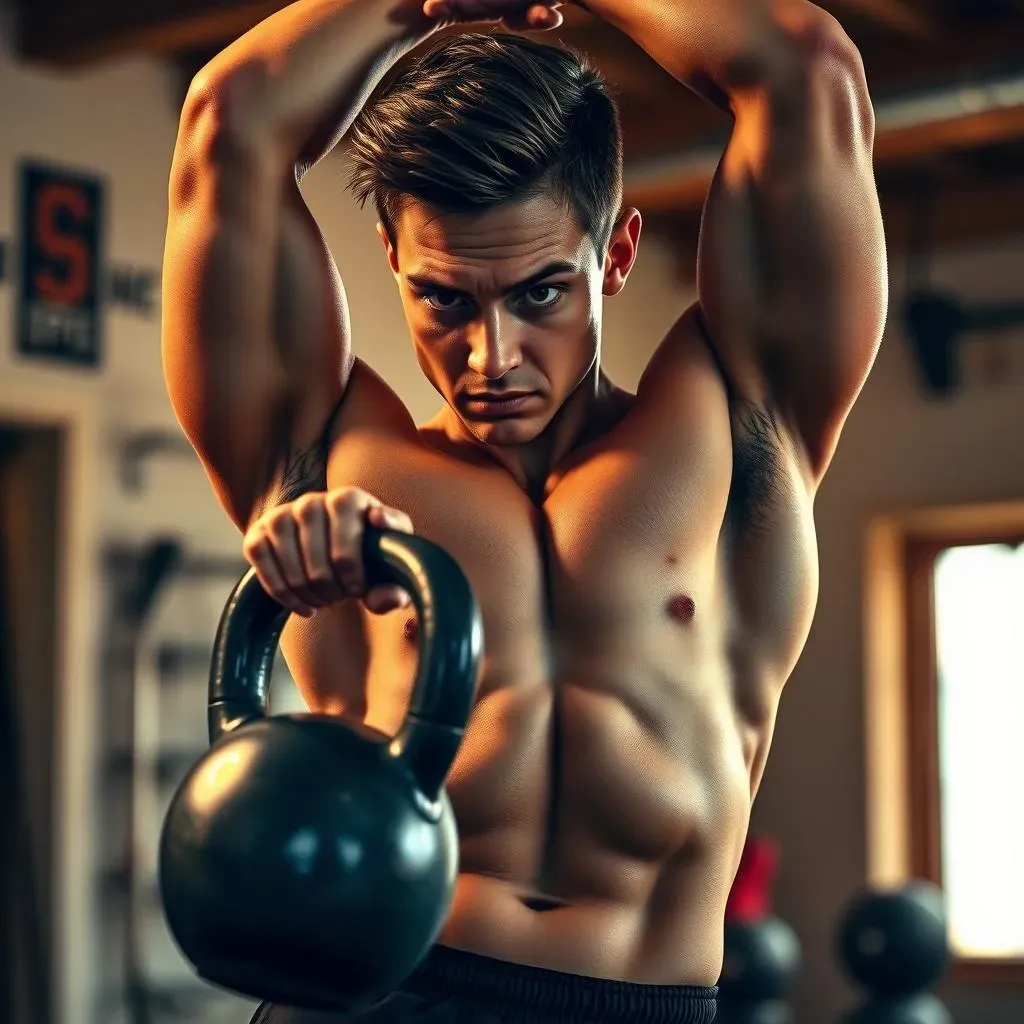Table of Contents
Ever wondered if those cannonball-looking weights could be the secret to a stronger midsection? You're not alone. The question, "are kettlebells good for core?" pops up a lot, and for good reason. We're constantly bombarded with ads for gizmos and gadgets, but sometimes the best tools are the simplest. Kettlebells aren't just for swinging around; they can be a powerhouse for building a core that's not only strong but also functional. Forget endless crunches; we're talking about movements that engage your entire body, sculpting abs while boosting your power and stability. In this article, we'll explore why kettlebells are core workout all-stars, show you the top exercises, and give you the real deal on how to make them work for you. Get ready to ditch the sit-ups and embrace a more dynamic approach to core training.
Why Kettlebells Are Core Workout AllStars

Why Kettlebells Are Core Workout AllStars
The Core Connection: It's More Than Just Abs
so you're thinking about a six-pack, right? Sure, kettlebells can help with that, but it’s much more than just aesthetics. When you swing a kettlebell, your core muscles are working overtime to keep you stable. It's not just your abs; it's your obliques, lower back, and even the tiny muscles around your spine. This creates a powerhouse of strength that you use in everyday life, not just in the gym. Think about picking up a heavy box – that's your core in action, and kettlebells train those exact muscles. It's like having a built-in weightlifting belt, only way cooler.
Unlike those boring sit-ups, kettlebell movements are dynamic and functional. We're talking about real-world strength here. The offset weight of the kettlebell forces your core to constantly adjust and stabilize, making it more effective than crunches. You are not just working your muscles; you're teaching them to work together. It's like having a conductor leading an orchestra of muscles, creating a symphony of strength. And trust me, that's way more fun than just staring at the ceiling while you do crunches.
Why Kettlebells Beat the Crunch
Let's be real, crunches are the beige of the exercise world – they're dull and they don't do much for true core strength. Kettlebells, on the other hand, are like the neon-colored sports car of core training. The dynamic movements, such as swings, snatches, and windmills, engage your core in a way that crunches simply can't. They force your body to stabilize, rotate, and resist forces, which is how your core is actually used in everyday situations. It's like your core is getting a full-body workout, not just a quick flex.
Kettlebells also help improve your balance and coordination. When you're swinging a kettlebell, you're not just working your core, you're improving your proprioception, which is your body's awareness of its position in space. This is crucial for everything from walking up stairs to playing sports. It's like your body is learning to be more graceful, more athletic, and more powerful, all at the same time. It's a win-win, or should I say a swing-swing?
Exercise | Why It's Core Focused | Benefit |
|---|---|---|
Kettlebell Swings | Engages the entire core to stabilize and generate power | Power, stability, and endurance |
Kettlebell Goblet Squats | Activates core to maintain upright posture | Strength and stability |
Kettlebell Windmill | Torsional core strength, oblique activation | Balance, stability, rotational power |
Top Kettlebell Exercises for a RockSolid Core

Top Kettlebell Exercises for a RockSolid Core
The Mighty Swing: Core Powerhouse
Alright, let's talk swings. If there's one kettlebell move that screams "core," it's the swing. It's not just about heaving the weight up; it's about using your hips and core to generate power. Think of your core as the engine and your legs as the wheels. You're not lifting with your arms; you're driving the movement from your center. Done right, this move hits your abs, obliques, lower back, and glutes like nothing else. It's like a full-body core workout disguised as a simple swing. Plus, it’s a great way to get your heart rate up. It's not just a core exercise; it’s a conditioning powerhouse.
Make sure you're hinging at the hips, not squatting. The kettlebell should feel like an extension of your arm, not something you're pulling up with your biceps. Keep your back straight, and brace your core hard. Imagine you're about to get punched in the stomach, and that's how you should engage your core. The swing isn't just about lifting the weight; it's about controlling it. It's about generating power from your hips and core, and that's where the real magic happens. If you master the swing, you're well on your way to a rock-solid core.
Goblet Squats: Core Stability Test
Next up, we have the goblet squat. This move is sneaky good for your core. You're holding the kettlebell close to your chest, which forces your core to work overtime to keep you upright. It's like giving your core a stability test. As you squat down, your core is working hard to keep you from falling forward or backward. It's not just about squatting down and standing up; it's about maintaining control and stability throughout the whole movement. It's like your core is the anchor that's keeping your body steady.
Make sure you're keeping your chest up and your back straight. Don't let the kettlebell pull you forward. The goblet squat is a great way to build core strength while also working your legs and glutes. It's like hitting multiple birds with one stone, but in a good way. You're not just working one muscle group; you're working your entire body. If you want a strong core, don't skip the goblet squat. It's a deceptively simple move that packs a serious punch.
Exercise | How to Do It | Core Benefit |
|---|---|---|
Kettlebell Swing | Hinge at hips, drive with glutes, swing weight to chest height | Full core engagement, power development |
Goblet Squat | Hold kettlebell at chest, squat down, keep chest up | Core stabilization, upright posture |
The Windmill: Core Rotation Power
Last but certainly not least, let's talk about the windmill. This exercise is a bit more advanced, but it's worth the effort. The windmill is all about rotational core strength. You're reaching down towards the ground while keeping your arm straight up, and your core is working overtime to keep you stable and balanced. It's like your core is the axis around which your body is rotating. It's not just about bending over; it's about maintaining control and stability throughout the whole movement. This move hits your obliques hard, giving you that sculpted look and rotational power.
The key to the windmill is to move slowly and deliberately. Don't rush the movement. Keep your eyes on the kettlebell, and make sure you're not collapsing forward. The windmill is a great way to improve your balance, flexibility, and core strength. It's like your core is learning to work in all planes of motion. It's a challenging exercise, but the results are worth it. If you want a core that's not only strong but also functional, the windmill is a must-try.
Are Kettlebells Good for Core: Real Results and How to Get Them

Are Kettlebells Good for Core: Real Results and How to Get Them
Real-World Core Strength: It's Not Just About the Abs
So, you've seen the exercises, you know the theory, but does it actually work? Absolutely. The beauty of kettlebell training is that it translates to real-world strength. It's not just about looking good in a mirror; it's about being able to move better, lift heavier, and feel more stable in your everyday life. Think about carrying groceries, moving furniture, or even just playing with your kids – a strong core is essential for all of that. Kettlebells help you build a core that's not just for show; it's a core that's functional, powerful, and ready for anything. It's like having a superhero core, without the cape.
The results you get from kettlebell training aren't just limited to your core. You'll also notice improvements in your overall strength, endurance, and balance. Kettlebells engage multiple muscle groups at once, making your workouts more efficient and effective. It's like getting a full-body workout in a fraction of the time. Plus, the dynamic nature of kettlebell movements helps improve your coordination and agility. It's not just about building muscle; it's about building a body that's strong, flexible, and ready for action. It's like your body is becoming a well-oiled machine, ready to tackle any challenge.
Benefit | How Kettlebells Help | Real-World Example |
|---|---|---|
Improved Stability | Core muscles work to stabilize during lifts | Easier to balance when carrying heavy items |
Increased Power | Hip hinge and core engagement generate force | More force when swinging a bat or racket |
Better Posture | Core strength supports upright position | Sitting or standing for long periods without back pain |
Tips for Getting the Most Out of Your Kettlebell Core Workouts
so you're ready to get started. Here's the deal: form is key. You can have all the enthusiasm in the world, but if your form is off, you're not going to see the results you want, and you might even get injured. Start with a lighter weight and focus on mastering the movements first. It's not about how much you can lift; it's about how well you can move. It's like learning to play a new instrument; you start with the basics before you try to play a symphony. Once you've got the form down, then you can start to increase the weight. Rome wasn't built in a day, and neither is a rock-solid core.
Consistency is also super important. You can't just do a few kettlebell workouts and expect to see results. You need to make it a regular part of your routine. Aim for at least two to three kettlebell workouts per week, and mix up your exercises to keep your body guessing. It's like giving your muscles a variety of challenges, preventing them from getting bored. Listen to your body, and don't be afraid to take rest days when you need them. It's not about pushing yourself to the limit every single workout; it's about making steady progress over time. It's a marathon, not a sprint, so pace yourself, and you'll get there.
Wrapping Up: Kettlebells and Your Core
So, are kettlebells good for core? The answer is a resounding yes, but with a side of "it depends." They aren't magic wands, but they are incredibly effective tools when used correctly. They challenge your core in ways traditional exercises often miss, forcing your muscles to work together to stabilize and control the weight. It’s not just about achieving washboard abs; it’s about building a stronger, more resilient body. If you’re after a core that can handle real-world demands, kettlebells deserve a spot in your routine. Just remember, proper form is key, so start slow, learn the basics, and get ready to feel the burn, and see the results.